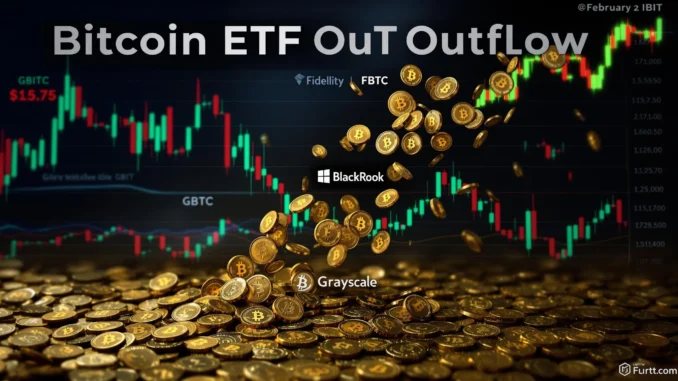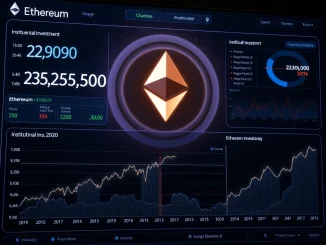
Hold onto your hats, crypto enthusiasts! February just wrapped up, and it brought a whirlwind of activity in the U.S. spot Bitcoin (BTC) ETF market – but not the kind many were hoping for. Buckle up as we dive into the surprising turn of events that saw a significant net outflow from these much-anticipated investment vehicles. This isn’t just a minor dip; we’re talking about a substantial Bitcoin ETF outflow of $3.546 billion in February alone! Let’s unpack what happened, which ETFs were most affected, and what this could mean for the future of crypto investments.
Decoding the February Bitcoin ETF Outflows: A Shocking $3.546 Billion Exit
According to insights shared by Trader T (@thepfund) on X, February witnessed a complete reversal of fortunes for U.S. BTC ETFs. Contrary to expectations, every single spot Bitcoin ETF experienced outflows throughout the month. This collective exodus resulted in a staggering $3.546 billion leaving the market. To put this into perspective, it’s a considerable shift from the initial excitement and inflows that greeted these ETFs upon their launch. But which funds bore the brunt of these withdrawals?
Let’s break down the outflow leaders:
- Fidelity’s FBTC: Topping the charts with a massive $1.202 billion in outflows. This is a significant figure, indicating substantial investor withdrawals from one of the leading ETF providers.
- BlackRock’s IBIT: Clocking in at $721 million in outflows. What makes this particularly noteworthy is that February marked the very first month that BlackRock’s IBIT experienced outflows since its inception. This fund had been a beacon of positive flows previously, making this shift all the more impactful.
- Grayscale’s GBTC: Continuing its trend, Grayscale’s GBTC saw withdrawals of $404 million. GBTC has been under pressure since its conversion to an ETF, and these figures highlight ongoing investor repositioning.
- BTC (presumably referring to another ETF or collective smaller outflows): Rounding out the list with $181 million in withdrawals.
To give you a clearer picture, here’s a table summarizing the ETF outflows February:
| ETF Provider | ETF Ticker | Net Outflow (February) |
|---|---|---|
| Fidelity | FBTC | $1.202 Billion |
| BlackRock | IBIT | $721 Million |
| Grayscale | GBTC | $404 Million |
| Other (Unspecified) | BTC | $181 Million |
| Total Net Outflow | $3.546 Billion |
Why the Sudden Exodus from Spot Bitcoin ETFs? Unpacking the Reasons Behind the Outflows
The million-dollar question (or rather, the $3.546 billion question) is: why did we witness such significant spot Bitcoin ETF outflows in February? Several factors could be at play, and it’s likely a combination of these elements contributing to the market dynamics:
- Profit Taking After Initial Hype: The launch of spot Bitcoin ETFs was met with considerable fanfare and initial inflows. It’s possible that some investors who entered early to capitalize on the hype decided to take profits in February, leading to outflows.
- Market Volatility and Uncertainty: February saw fluctuations in the broader cryptocurrency market and global economic uncertainties. Such volatility can make investors risk-averse, prompting them to pull funds from even relatively new investment products like spot Bitcoin ETFs.
- GBTC Conversion Dynamics: Grayscale’s GBTC, which converted from a trust to an ETF, has been facing consistent outflows. This is partly attributed to investors seeking to realize profits or switch to ETFs with lower fees. The ongoing GBTC outflows significantly contribute to the overall negative net flow.
- Shifting Investor Sentiment: Investor sentiment in the crypto market is notoriously fickle. Perhaps broader market narratives or concerns about regulatory scrutiny, macroeconomic factors, or even alternative investment opportunities influenced a shift in sentiment, leading to reduced appetite for Bitcoin ETFs.
- Rotation into Other Assets: It’s also possible that investors were reallocating capital to other asset classes, either within the crypto space (like specific altcoins) or outside of crypto altogether, seeking potentially higher or different returns.
Impact and Implications: What Do Bitcoin ETF Outflows Mean for the Crypto Market?
A $3.546 billion net outflow from Bitcoin ETF outflows is not a trivial event. It raises some crucial questions about the immediate and future implications for the cryptocurrency market:
- Potential Pressure on Bitcoin Price: While not the sole determinant, significant ETF outflows can exert downward pressure on the price of Bitcoin. Reduced demand from these investment vehicles can contribute to selling pressure in the market.
- Market Sentiment Indicator: These outflows could be interpreted as a signal of cooling enthusiasm or growing caution among investors regarding Bitcoin, at least in the short term. It’s essential to monitor if this is a temporary blip or a more sustained trend.
- ETF Provider Strategies: The ETF providers, especially Fidelity and BlackRock, will be closely watching these trends. They may need to adjust their strategies to regain investor confidence and attract inflows in the coming months. Marketing efforts, fee adjustments, or educational initiatives could be on the cards.
- Regulatory Scrutiny and Market Maturity: Periods of significant outflows, as well as inflows, will be closely observed by regulators. This real-world data on ETF performance and investor behavior will contribute to the ongoing evolution of crypto market regulations and the overall maturation of the digital asset space.
Navigating the Waters: What Should Crypto Investors Consider Amidst ETF Outflows?
So, what’s the takeaway for crypto investors amidst these ETF outflows February? It’s crucial to maintain a balanced perspective and consider the bigger picture:
- Don’t Panic Sell: Market fluctuations are inherent in the crypto world. A single month of ETF outflows doesn’t necessarily signify a long-term bearish trend. Avoid knee-jerk reactions based on short-term data.
- Monitor Trends Closely: Keep a close eye on ETF flow data in the coming weeks and months. Is this outflow trend continuing, or is it reversing? This will provide more clarity on the underlying market dynamics.
- Diversification Remains Key: As always, diversification is a prudent strategy. Don’t put all your eggs in one basket, whether it’s Bitcoin ETFs or any single asset class. A diversified portfolio can help mitigate risk.
- Long-Term Perspective: Remember that Bitcoin and the broader crypto market are still relatively nascent. Long-term investors should focus on the fundamental value proposition of Bitcoin and blockchain technology, rather than being swayed by short-term market noise.
- Seek Professional Advice: If you’re unsure how to navigate these market shifts, consider consulting with a financial advisor who understands the cryptocurrency space.
Conclusion: The Bitcoin ETF Journey Continues – Expect Volatility and Monitor Closely
February’s Bitcoin ETF plunge, marked by a substantial $3.546 billion net outflow, serves as a powerful reminder of the dynamic and often unpredictable nature of the cryptocurrency market. While the initial enthusiasm for spot Bitcoin ETFs was undeniable, market realities and investor sentiment can shift rapidly. The outflows, particularly the first-ever outflows from BlackRock’s IBIT, highlight that even established players are not immune to market fluctuations.
As we move forward, it will be crucial to monitor ETF flows, analyze market sentiment, and understand the broader macroeconomic context. The journey of Bitcoin ETFs in the U.S. is still in its early stages, and volatility is to be expected. For investors, staying informed, maintaining a long-term perspective, and making well-considered decisions will be paramount in navigating this evolving landscape. The crypto story is far from over; in fact, it’s constantly unfolding, with each month bringing new chapters and unexpected twists.



